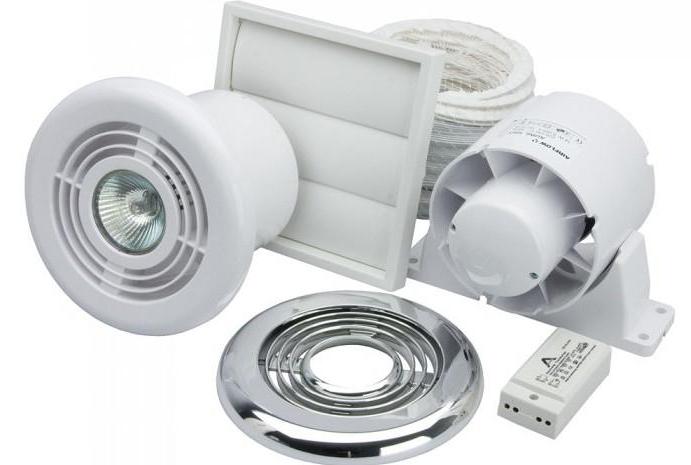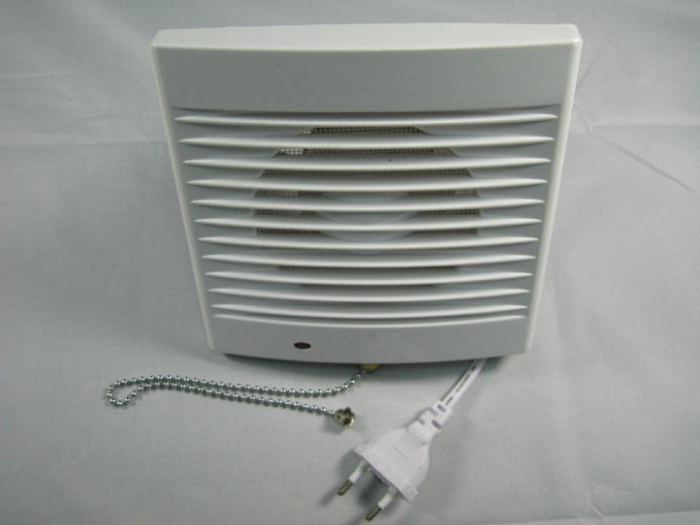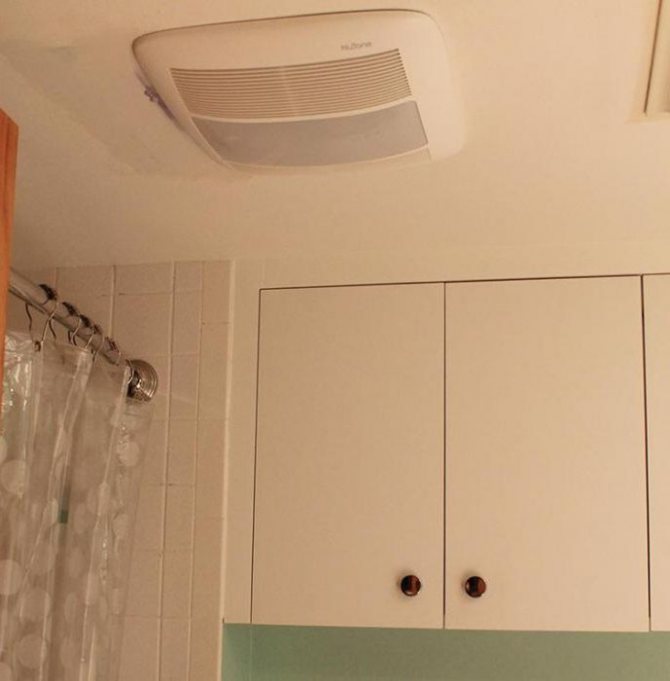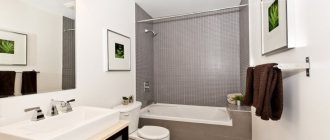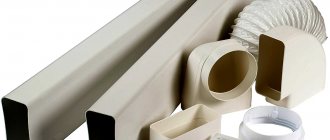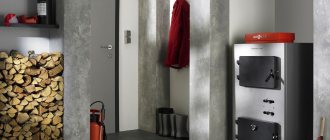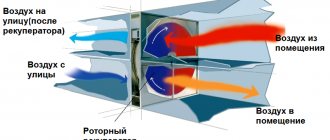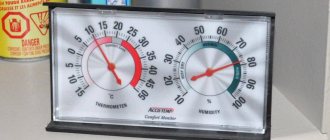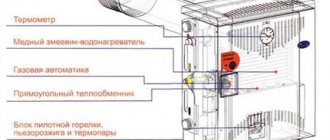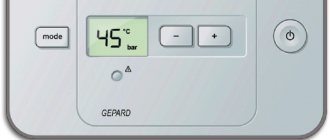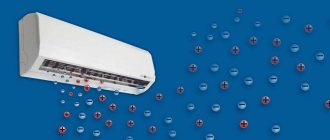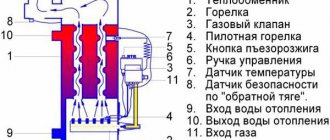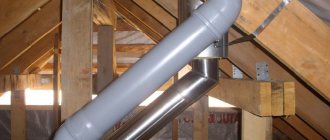Bathroom fans
Bathroom fans
- are now badly needed in every home. Due to the widespread installation of plastic windows, there is a need for forced ventilation, especially in the bathroom! High humidity is always present there, this not only brings discomfort, but can also cause mold and mildew on the walls.
How to choose a bathroom fan
Before buying a fan for a bathroom, you need to clarify the initial data of the room where the installation will be carried out:
- Installation location - in the wall or on the ceiling
- Duct connection or ventilation shaft installation
- Allowable hole diameter
Next, you need to pay attention to the characteristics of the fan. The most important of them are:
- Performance
- Electrical connection reliability
- Engine quality and build
- Material safety
- Noise level
Popular models
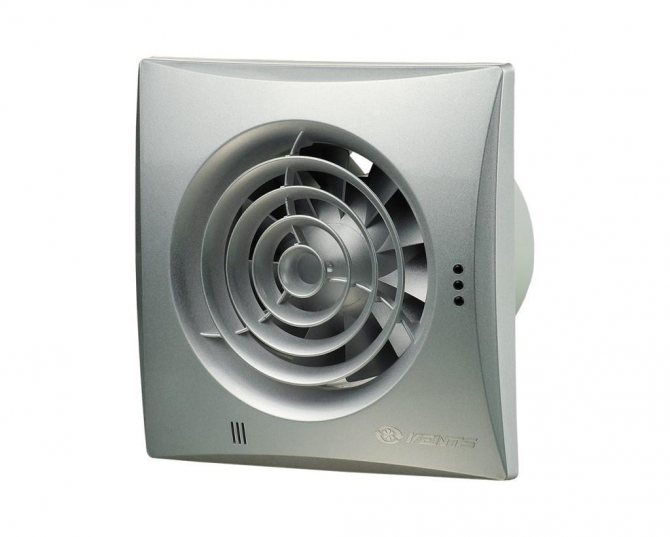
Brand model VENTS Quiet
Most often, buyers prefer the following products:
- VENTS Quiet. Noise level 25, manufacturer Ukraine. The price starts from 1200 rubles.
- Electrolux Rainbow Noise level 30, produced by a Swiss company. The cost of products from 1500 rubles.
- ERA series ERA is distinguished by a noise level of 25 units, is a product of a Russian manufacturer, which can be purchased at a price of 900 rubles.
The hoods in the toilet and bathroom are an indispensable part of the functioning of the room. Therefore, you should choose quality products.
Overhead fans
Overhead bathroom fans
- one of the most common types of fans for domestic use. During installation, this fan is superimposed on a wall or ceiling, and the inner part, a branch pipe, goes into the ventilation duct. It is this method of installation that became fundamental in the name of the type of this equipment.
The main function of overhead fans is to remove exhaust and humid air from the room. They are often installed in bathrooms, toilets, kitchens, laundries and other small and poorly ventilated areas. Good ventilation in rooms is important not only to remove the discomfort from excess moisture in the air, but also to prevent the appearance of mold and mildew, which are harmful to human health. Overhead fans provide you with comfortable, fresh air!
Overhead fans can be divided into:
The latter are quite rare, they are more expensive, but at the same time they have much higher performance. The high performance of centrifugal overhead fans is achieved by using a special centrifugal impeller with forward curved blades.
Varieties of hoods
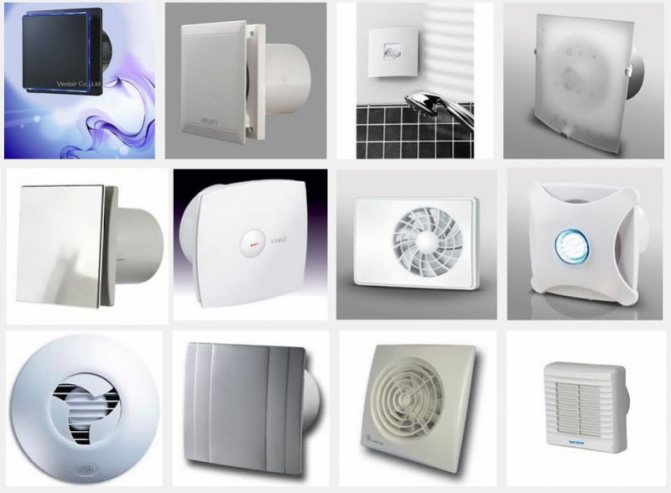

Before choosing a hood, you should understand their design features. There are two main types of fans:
- axial;
- centrifugal.
Axial fans - vane impeller in a housing with a motor that drives it. When rotating, the blades inclined inward suck in air and move it along the axis. Such devices are most popular for bathrooms in apartments. The devices are distinguished by their design, affordable price and ease of installation. They are installed on a wall in a ventilation shaft. Axial-type models are characterized by high efficiency and productivity. Hoods are made both up to 100 cubic meters per hour and with higher power. The higher the performance value, the larger the fan opening diameter. Benefits:
- high performance;
- noise level;
- the level of electricity consumption;
- compactness.
The inability to create high air pressure is distinguished from the disadvantages of the axial model.
Centrifugal (radial) fans - the structure consists of a paddle wheel located in a special casing. As the blades rotate, air enters inward, resulting in compression and throwing away by centrifugal force. The advantages are:
- improved aerodynamics;
- work in aggressive environments;
- air flow control.
Centrifugal hoods work well with high temperatures, suck out polluted air and are economical in electricity consumption. But they require an increased cross-section of the connection cable, and the noise level depends on the angle of inclination of the blades.
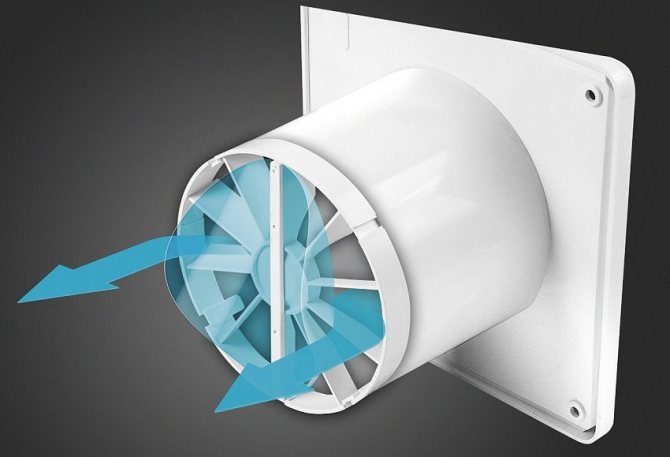

Hoods can also have additional design features such as humidity sensors, movement, timer or check valve. Let's take a look at each function separately.
Check valve - a device that regulates air outlet and supply. It must be used in cases where reverse draft is observed in the ventilation system. Food smells from neighbors, cigarette smoke, etc. should not enter the bathroom. If the hood has a non-return valve, air does not escape or enter the room when the device is turned off. The switched on hood opens the flaps with an air stream, due to which the ventilation process takes place. The disadvantages are the lack of natural air movement when the device is turned off.
Humidity sensor - measures the level of moisture in the air and, when the critical level is reached, turns on the hood. Thanks to the sensor, you can dispense with the switch when taking a shower.
Motion Sensor - reacts to the presence of a person in the room and turns on the hood. It is especially convenient to use such devices in the toilet.
Timer - allows you to program the operating time of the hood. The advantage is the setting of the schedule and uniform ventilation of the room throughout the day.
Price overhead fan
The price of overhead fans depends on many factors:
- Performance
- Nozzle diameter
- Check valve
- Additional functions: timer, humidity sensor, motion sensor, CO2 sensor, pull-cord switch, etc.
- Color and design
- Low noise
- Eco-friendly plastic
- Electrical connection safety
- Motor type: on sleeve bushings or ball bearings
- Country of Origin
- Control system
Thus, the choice of overhead fans seems to be quite large. In order not to get bogged down in a painful choice, it is recommended to determine the parameters that are important for you in advance. Remember that performance, quietness, reliability of the motor, electrical connection and environmental friendliness of materials are the main characteristics for a long and safe service of the clip-on fan.
If you need help or just want to find out the cost of an overhead fan, do not hesitate to contact the specialists of the Blagovest company, we are always happy to advise you!
Domestic exhaust duct fan with non-return valve
For a number of reasons, natural ventilation in rooms may not be able to remove unpleasant odors or moisture. This is due to redevelopment in the apartment or blockage of the exhaust shafts. Experts recommend that residents of such houses install an exhaust fan with a check valve. A wide range of such products is offered in retail chains, and sometimes it becomes difficult to choose the optimal device.
In ancient Egypt, people noticed the negative effect of stuffiness in the premises on the human body. The situation was aggravated if the kitchen was in the same building. Carbon monoxide filled the entire space, even causing suffocation.Chimneys were used to remove polluted air. For them to work correctly, it was necessary to organize a draft, but this did not always work out. Therefore, the creation of forced ventilation has become relevant.
In the 18th century, devices appeared that were the prototype of the modern fan. A plate bent in the horizontal plane was used as a supercharger, and its movement was due to a steam engine. Kerosene or alcohol was used as fuel.
The discovery of electricity and the creation of a power generator in 1831 allowed Robert Davidson to invent the modern engine. At the same time, Russian engineer Alexander Sablukov came up with a centrifugal fan. Its design consisted of a cylindrical casing with a wheel placed in it, which has four straight blades. The rotation of the wheel at that time was carried out manually. This invention began to be used to ventilate the cabins of ships and mines. In 1892, the French scientist P. Mortier proposed a version of the cross-flow fan. It used a drum-type wheel with curved blades.
The blades of the exhaust device received a modern look after the research of Nikolai Yegorovich Zhukovsky, who studies aerodynamics and created the vortex theory of the wing. The creation of the first electric fan is credited to Thomas Edison. But it is known for certain that drawings of a device resembling a fan are found in the records of Leonardo Da Vinci.
The most demanded rooms in which exhaust devices are installed are sanitary rooms, kitchens and bathrooms. This is due to the poor natural removal of unpleasant odors and moisture from them. The hood in apartment buildings is usually built taking into account the supply air coming from the windows of the apartment. But due to the replacement of old frames with metal-plastic ones, its supply stops, so you have to keep the windows in a state of ventilation, which is not always convenient.
There is another reason, which is that forced powerful hoods can be installed in neighboring apartments. Their strength can be so great that the removed air begins to be blown out of the ventilation ducts into the middle of the rooms located above or below the riser.
Bathrooms and sanitary rooms are initially located in remote parts of the apartment from the windows. Therefore, the flow of fresh air there is even more difficult. After taking water procedures, the humidity rises, and it must be removed. If this is not done, mold and mildew will form, adversely affecting the health of residents. In addition, furniture and other items become unusable.
Also, if any kind of work was carried out in the house, the hood could be damaged, as a result, unpleasant odors begin to drag on from unscrupulous neighbors. Therefore, the hood with a non-return valve to the bathroom, a toilet or kitchen is installed in the following cases:
- an unpleasant odor in the room, emerging from the apartment shaft;
- weak natural draft, which leads to the formation of stagnant air;
- clogged mine of a residential complex;
- mold and mildew formation;
- lack of the ability to organize a constant supply of fresh air.
Ventilation valve - where and how to put
If the ventilation system is made without the use of fans and hoods with motors, it is called natural. For everything to work, valves are installed immediately at the outlet of the channels to overlap the reverse thrust. To maintain normal circulation, it is advisable not to use grids that overlap the valve. Yes, this option looks better, but ventilation suffers at the same time. Most likely, it simply will not work with a small traction.
If you still want to install a decorative ventilation grill in front of the valve, you will have to put up with a deterioration in ventilation, slower removal of odor and excess moisture. Only the installation of a grille / valve with a larger diameter than calculated can help. In this case, air exchange will not be affected.
Natural ventilation works due to temperature differences and pressure differences
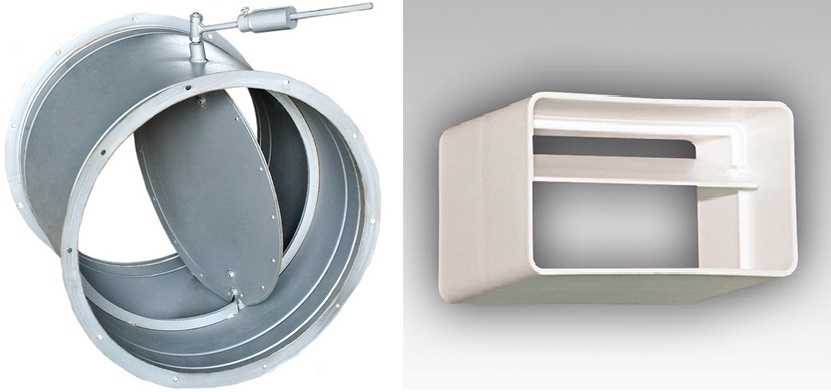

In the case of forced ventilation, the non-return valve can be placed either in front of or after the fan. This choice depends on the type of system and fan. Since ducted models of fans in private systems are rarely used, it usually turns out that the damper is located after the fan in the pipe. How far away doesn't matter. The main criterion for choosing an installation site is ease of maintenance, since the damper will have to be periodically cleaned and checked.
Installation in a kitchen with a cooker hood
When installing a forced draft hood in the kitchen, many people want to preserve natural ventilation. To do this, you need to install a tee at the entrance to the ventilation duct. Connect a hood with a check valve to one of its inputs, and put only a check valve in the second. As you can see, the system is not too complicated, but it works.
How to connect an extractor hood so that natural ventilation remains


Why should there also be a check valve on the hood? Because if it is not there, the return air flow can pass through the hood. Yes, it will not happen every time, but with a strong flow it will.
When installing this unit, try to make sure that the ventilation check valve is located as high as possible under the ceiling. As a result, the warmest and wettest part of the air will be removed, which is very important for the kitchen.
For bathroom and toilet
The ventilation of the bathroom can have its own exhaust duct - then everything is easy, simple and understandable. Before entering the ventilation duct, we put a check valve to shut off the air flow that will move into the room. But not all apartments can boast of individual bathroom and toilet shafts. In some old-style houses, there is only an exhaust duct in the toilet. Ventilation of the bathroom is done by passing the box through the wall. In this case, we put a check valve for ventilation not only at the outlet to the ventilation duct, but also in the channel between the bathroom and the toilet. This will prevent unpleasant odors from entering the bathroom.
How to put a check valve for ventilation in a separate bathroom with one ventilation duct
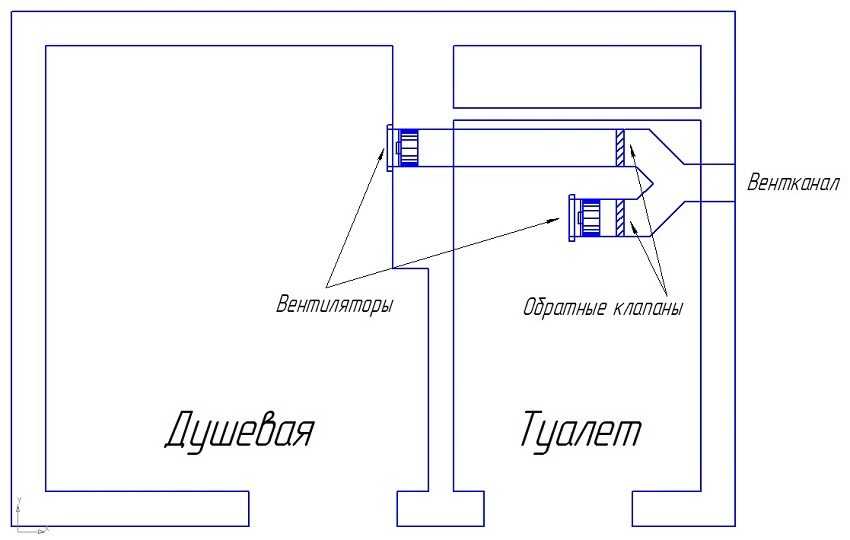

There is an even more sad situation: when there is only one exhaust duct and it is in the kitchen. Actually, the logic of the installation does not change - it is necessary to place the devices so that smells from one room do not get into another.
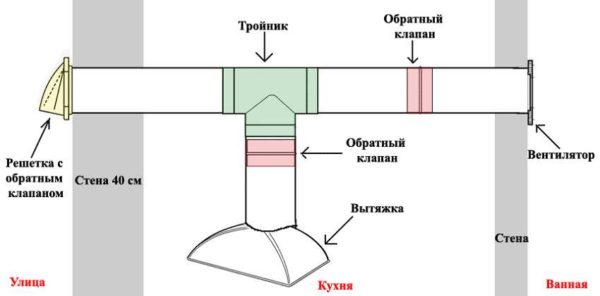

One check valve for ventilation is placed on the outlet to the dome hood (or on the channel that removes air from the kitchen), the second on the pipe that goes from the bathroom. As you can see, if you understand the logic of the work, you can determine the most successful installation place yourself.
Good ventilation in the bathroom will protect the room from mold.
The bathroom, as a room with a high level of humidity, has special requirements for ventilation. In simple terms, it must be ventilated sufficiently intensively to create and maintain a healthy environment, due to the fact that when taking a bath or shower, a large amount of steam is generated in the bathroom, which can damage the finish or worsen the microclimate. There is a silent bathroom fan with a non-return valve, which almost completely meets these conditions.
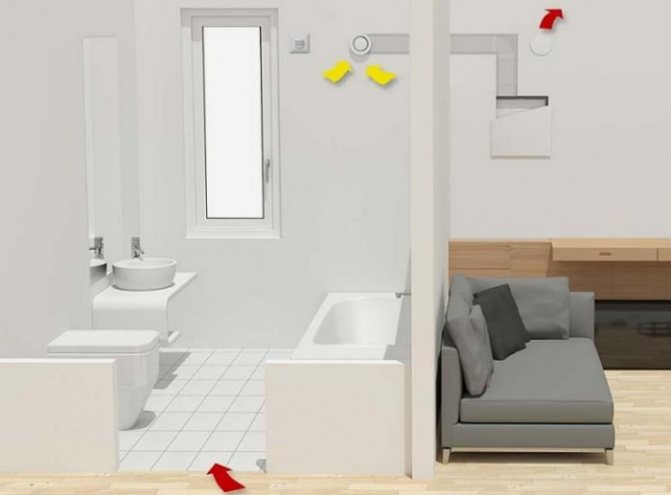

Why do you need a bathroom fan?
Installation of this particular device with a check valve is the most rational solution.Special requirements for ventilation in rooms with high humidity levels are as follows:
- ventilation should ensure air circulation in the room;
- normalization of humidity in the room.
Fact! 25 m³ / hour for a separate bathroom and 50 m³ / hour for a combined one. This should be the intensity of air flows for the normal functioning of natural or artificial ventilation in the bathroom and toilet.
A high level of humidity in the bathroom creates favorable conditions for the appearance and growth of fungi and mold, which can cause furniture to deteriorate, the floor, walls, ceiling and their coatings to collapse. Even moisture-resistant equipment is recommended to be used in drier rooms in order to extend its service life.
Musty air can negatively affect health. In addition, the humid environment of the bathroom can contribute to the fact that insects can start in it. And, in the end, the unpleasant smell from the ventilation ducts is quite unpleasant. All this reduces the level of comfort when using these premises.
Good air circulation helps to normalize indoor humidity levels and prevent steam from entering living rooms through cracks in doors. Installation of a silent fan with a non-return valve will allow all this to be done.
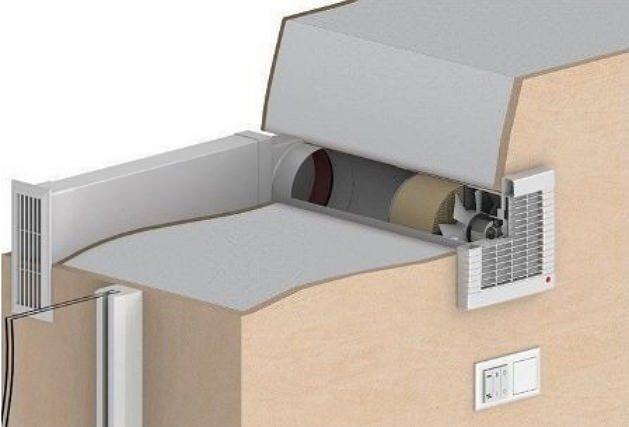

What is a check valve for ventilation
During normal operation of the exhaust ventilation, air moves from the room to the street. Exhaust openings are located "in dirty or wet" rooms - a bathroom, a kitchen. The task of this part of the ventilation system is to bring odors and excess moisture out into the street. But sometimes a situation arises when through the exhaust ventilation the air goes in the opposite direction - it enters the premises. This moment is called thrust rollover and they try to fight this phenomenon.
A check valve for ventilation is needed for the normal operation of the system
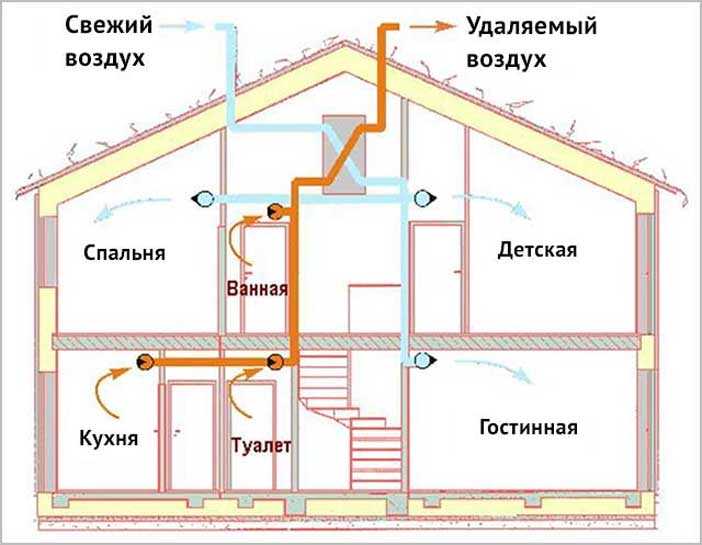

Why fight back thrust? In the case of apartments, this is fraught with odors from neighbors, which is very unpleasant. If we consider private houses, portions of outside air in them reduce the temperature in winter. The second moment is more dangerous and unpleasant - during reverse draft, the boiler can go out, combustion products (and carbon monoxide too) can return to the room from the chimney. In any case, the reverse movement of the air flow is an incorrect operation of the ventilation system and this phenomenon must be fought. A check valve for ventilation is just put in order to block the movement of air in the wrong direction.
Why is it better to equip artificial ventilation?
There are two main types of indoor ventilation:
- Natural supply and exhaust.
- Artificial, with forced air exchange.
Natural supply and exhaust ventilation is one of the standard solutions to the problem of air circulation in most of today's apartment and private houses. The system works with a combination of air inlets and exhaust air vents. The role of inlet openings is played by window vents, ventilation recesses in the lower part of the doors, gaps between the door and the floor.
The quality of natural supply and exhaust ventilation directly depends on the draft in the exhaust ducts, which is obtained due to the difference in pressure between the outside and inside. Exhaust openings are made in the form of vents in the ceiling or in the upper part of the walls near the ceiling itself. The supply openings cannot provide sufficient supply flow rates. Because of this, natural exhaust ventilation does not satisfy the conditions for the formation of the correct microclimate in the bathroom.
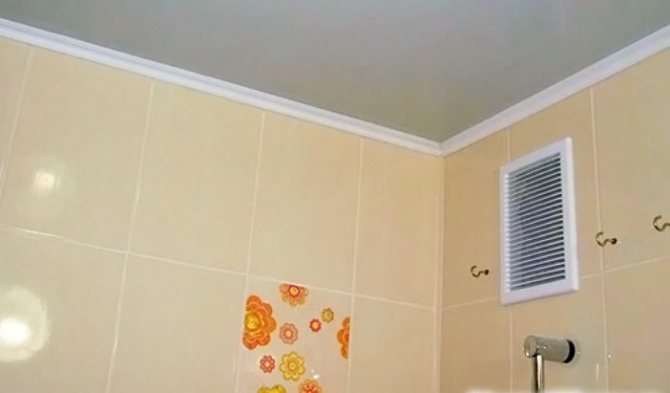

To ventilate the bathroom or toilet, you need to install artificial ventilation with forced air exchange.
There are two types of artificial ventilation:
- Natural air inflow and forced air extraction is a supply complex.
- Artificial air supply and its natural exit from the room.
To ensure forced air exchange, it is necessary to equip a network of air ducts through which the processed air masses will be removed from the room. In order to achieve the necessary conditions for creating a comfortable microclimate for the intensity of air flows, this ventilation system is equipped with fans. A bathroom hood with a non-return valve is much more efficient.
Exhaust device in the bathroom
What is a standard toilet ventilation system? As in any other room, it needs supply and exhaust ducts. In almost 100 percent of cases, the doorway is the first. And the exhaust outlet, located under the ceiling opposite the door, or somewhere in the corner, is responsible for removing air from the room. Thanks to this arrangement, there are no blind spots left in the system, where moisture will accumulate, thereby damaging the walls (black spots).
Advice. Do not install an exhaust vent above the door, as this will impair the ventilation of the room.
How to check the ventilation system?
In order to check if the ventilation system is working properly, use a lighted match. According to Soviet standards, it is accepted that when it is brought to the exhaust hole, it should go out, but this does not always happen. What are the reasons? The answer may lie in poor fresh air supply. How can this issue be resolved? There are several solutions:
- Always leave the front door slightly ajar or open completely. But not all owners want to do this, then you can choose one of the following solution options.
- Increase the distance from the floor to the door to 2 centimeters. This should be enough so that the circulation does not stop and is intense enough.
- Install special valves at the bottom of the door. They will allow you to run fresh air inside, while not removing waste air into the space of the apartment.
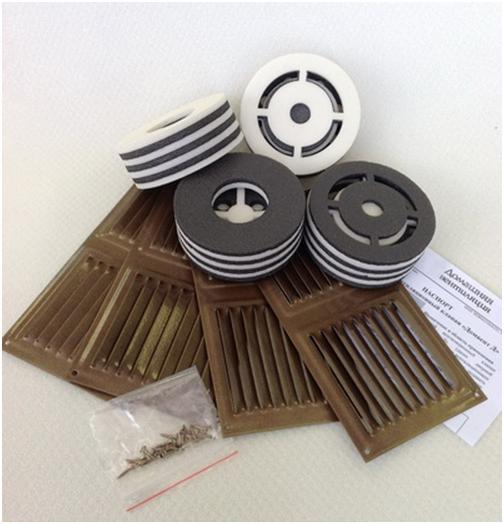

Door valves
In addition to the problem with the flow, it can happen that the air ducts are too dirty. In this case, they are cleaned and checked again. If cleaning and organizing a good inflow will not give any result, then a mechanical exhaust in the toilet is required, that is, a fan.
Forced ventilation
Forced ventilation is a ventilation system in which a fan serves as the main tool for exhausting exhaust air.
Mechanical ventilation is of different types, but specifically for a toilet with a bath in a domestic environment, an exhaust outlet is used, where the blower is mounted only in the exhaust hole. All other principles - the placement of air ducts, inflow, etc., are organized, as in the natural ventilation system (it is already installed in your apartment).
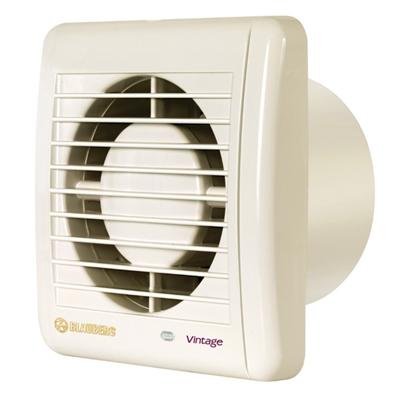

Bathroom ventilation device
Device and principle of operation
An exhaust fan in the bathroom, equipped with a check valve, looks like a fairly simple device that prevents air from backflowing from the ventilation duct. The check valve is usually made of plastic or stainless steel. They consist of three main parts - a frame of two shutters and a pin on which the shutters are attached.
In addition to the check valve, the silent fan consists of the following parts: Air intake grille, aerodynamic impeller, vibration damping inserts and a motor.
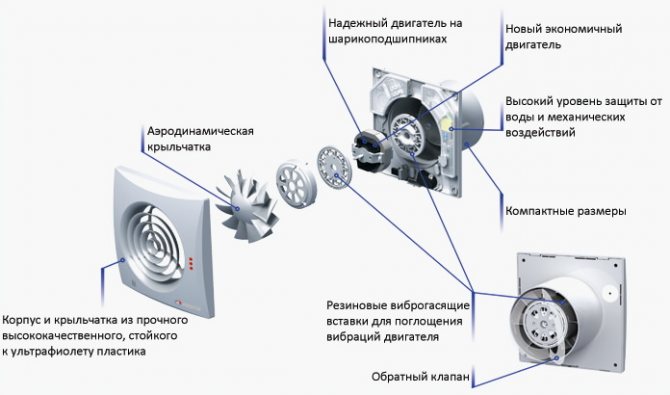

The principle of the check valve, regardless of where it is installed - in a sewer pipe or a ventilation shaft - is in no way different. It is made in such a way that the movement of water or air (depending on the place of installation) passes only in one direction. When you try to go back, air or water will be blocked by tightly closed flaps.
The sash is driven directly by air, which is naturally done at the moment the fan is turned on. The air is drawn out until the fan turns off. As soon as this happens, the flaps slam shut and block the return path of air.
And now let's briefly tell you about some of the features of the silent fan device:
- The design of the engine provides for the presence of special vibration isolating elements that absorb vibration, which is the main source of noise.
- Manufacturers are very careful with the appearance of the fan. The intake grille is streamlined. In addition, the material itself plays an important role, from which the grille is made - the air resistance depends on it.
- Quiet operation is also based on a different bearing model. In addition to noise absorption, they have a high degree of reliability and do not require additional maintenance (in particular, lubrication).
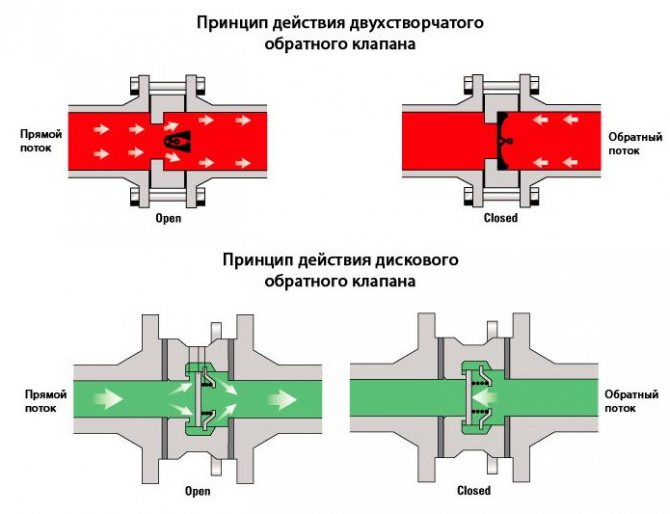

How to choose a bathroom fan?
Nowadays, there are a lot of models for air ventilation on the market, both from domestic and foreign manufacturers. What are the first things to look for when buying an exhaust fan? These characteristics are: productivity, efficiency and comfort in use.
- Performance. To determine the required fan performance for a bathroom, you need to know the volume of the room and the rate of air exchange. It is determined by sanitary standards and depends on the type and purpose of the premises. For bathrooms, this value is 6-8. To calculate the performance of the exhaust fan, you need to multiply the volume of the room by the air exchange rate.
- Profitability. Together with the conventional models, which consist of blades and a switch, but removed together, you can find models equipped with additional functions that can reduce energy consumption. The most common are the presence of motion and humidity sensors, there are also models equipped with a timer.
- Moisture sensor. The switching on and off of a fan equipped with this sensor depends on the humidity level of the room. The fan starts working when the humidity level reaches a certain point, and stops it when it drops to the set value. Such models are most preferable if there is a goal to save energy consumption.
- Motion Sensor. These models help to save electricity, as they react to movement in the room. That is, they start up only at the moment when there is someone in the bathroom or toilet, and turn off when there is no one there. The disadvantages of such models include the possibility of an involuntary shutdown, due to the fact that there is not enough traffic in the bathroom "in the opinion" of the sensor.
- Timer. The most rational solution to the problem of energy saving and room ventilation is a fan with a timer. This fan automatically starts to work at a specified time, and turns off after a specified period of time. The operating time depends on the bathroom and the intensity of its use.
- Comfort during operation. Depends on the level of noise generated during operation. There are no completely silent fans. But the sound created by modern models does not create discomfort. Since it does not exceed 35 decibels.
- Performance. The most famous manufacturers are: Vents, Maico, Soler & Palau, Helios. They produce models that are of high quality and long-term durability, and besides, they have a low level of noise during operation and a high level of moisture resistance.
Fan installation
The fan is installed on the foam.Typically, the exhaust fan is sold with a 100 mm diameter thin tube that should be foamed into a large hole in the wall. To prevent the pipe from squeezing during the expansion of the foam, the fan must either be immediately inserted into it, or instead of the standard pipe, buy a stronger sewer pipe of the same diameter (usually 100 mm). The body of the device does not fit tightly into such a pipe, but this inconvenience can be easily eliminated by putting on tight rubber rings, which can be purchased at hardware stores, on the fan body.
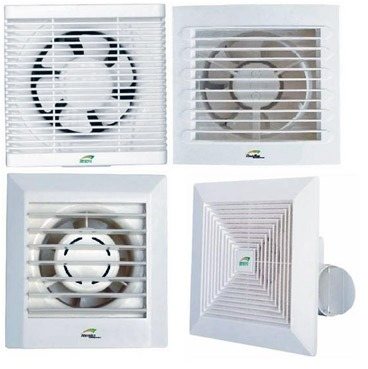

The fan connection diagram must be calculated in such a way that it starts either immediately with the light on, or by a timer, as described above. It is recommended to have an additional separate switch for the hood. This may be needed if the room needs light, but the air extract is not.
When creating ventilation in the toilet, it is important to remember that ideally it should be a separate air duct, not combined with any other. It is strictly forbidden to combine the exhaust duct with a forced fan and any other air ducts operating on the principle of natural draft. A single ventilation system that effectively removes exhaust air from all rooms in a house or apartment requires a detailed calculation. The process of creating such a scheme for a qualified specialist takes several hours.
To organize a high-quality hood in the toilet with your own hands, it is better to create a separate ventilation duct once, than then invest a lot of time and effort to achieve the correct distribution of air flows inside the combined duct. At the same time, we must not forget about the inflow of fresh air, it must necessarily be less intense than its outflow.
How to install a bathroom fan with a non-return valve?
There are two types of bathroom fans: axial and ducted.
- An axial fan is a small propeller with blades whose task is to draw in moist air while rotating and thus remove it into the mine. These devices are suitable for small bathrooms (up to 15 m3), which are not connected by one shaft to other rooms. They allow for good ventilation, and at the same time are quite cheap. The only drawback is that they are noisier compared to duct fans.
- Duct exhaust fan - is a more advanced mechanism, which is a turbine with a volute placed in a plastic casing. This fan actively sucks in air, ventilating the room well and with high quality, is intended for bathrooms with a volume of more than 15 m3, combined bathrooms or with clogged natural ventilation ducts. Duct fans with a check valve for the bathroom have high reliability, performance and low noise level during operation. The only drawback of this dress is the rather high price.
In industrial premises, the third type of fans with a non-return valve is usually installed - radial. These are large models with a spiral grille.
The installation of a fan with a non-return valve is best carried out in the air duct of the bathroom exhaust or at the entrance to the exhaust air lock. These holes are usually found in the wall or ceiling in the corner opposite the front door. The overhead fan model with an axial mechanism must be fixed directly in front of the ventilation opening.
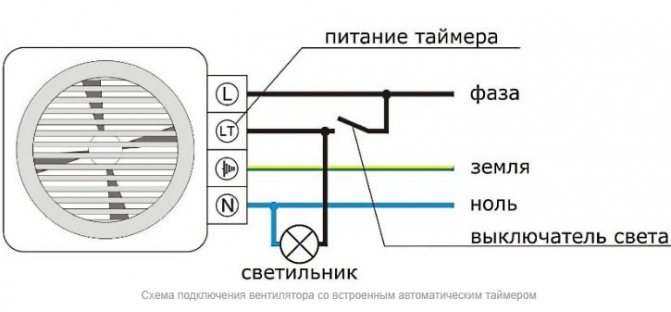

In the event that a duct ventilation device is used, it must be inserted into the hole and covered with a decorative grill. It should be noted that the duct fan has a low noise level during operation due to the fact that its motor is located in the ventilation hole.
- Power to the device must be fed from the box to which the lighting system is connected.
- The wires that go to the fan must be hidden in the grooves or under the false ceiling.
- Use a pre-made hole in the wall to install the device. Insert the plastic ventilation duct flush with the wall and reinforce it with plaster, then connect the power supply and install the hood.
- The ventilation pipe can be replaced with a 100 mm PVC drainage pipe.
- You need to remove the top cover from the device and lubricate its back with liquid nails, then install the fan, pressing its back to the wall.
- Be sure to install the ventilation grill by screwing it in with screws or placing it on the latches. Tip: The grate must be regularly cleaned of dust.
In order to power the installed device from the mains, they throw a cable from the nearest box. At this time, you need to remember about the need to comply with the rules of electrification for rooms with high levels of humidity by placing the cable in a special protective channel and hiding it behind a suspended ceiling, wall panels or plaster.
The Silent Exhaust Fan is a simple yet effective device that helps to reduce the level of humidity and increase the rate of air exchange, thereby creating a more comfortable environment in the bathroom. Modern models of this device are easy to install, have a high level of reliability during operation and are equipped with automatic start and stop systems, and the combination of practicality and aesthetic appearance will allow them to fit into any bathroom interior.
How to install correctly
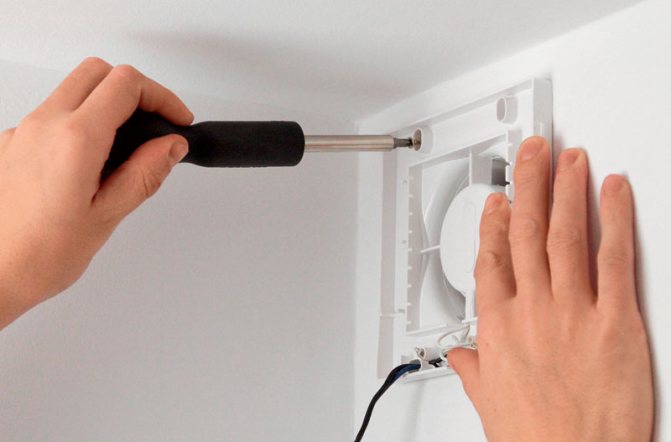

The installation process involves preliminary preparation. If a rough and final repair is being done in the apartment, it is necessary to lead the cable to the place where the fan is installed and prepare a hole so as not to damage the tile later. Wire cross-section and hole size depend on the selected fan model. Step-by-step installation instructions:
- The fan must be disassembled by removing the top panel and getting to the power connection point.
- Turn off the mains voltage and make sure it is not there. After that, connect the phase, zero and ground to the required terminals and securely clamp the contacts with a screwdriver.
- Switch on the general voltage and using the switch and check the functionality of the device. If only automatic switching is provided, open hot water and wait for the device to work.
- If everything is in order, you need to install the fan in the prepared hole. It is enough to insert it inside and fix it in the prescribed way. Most household hoods are fixed to the wall with dowels. When it is not possible to drill holes, special silicone is used for firm fixation.
- After installation, the top panel of the device is put back and its performance is checked. This completes the installation process.

